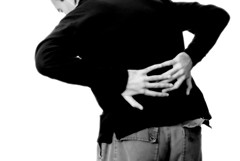Harvard Health Blog
Back pain often overdiagnosed and overtreated

What doctors call “routine” back pain can really, really hurt. Surprisingly, the best treatment is usually quite conservative—over-the-counter pain relievers, ice and heat, and gentle exercise. Yet for decades, many doctors have been ordering more and more unnecessary tests, narcotics, and referrals to surgery.
“Most routine back pain will improve on its own with conservative therapy in three months, often shorter than that,” says Dr. Bruce E. Landon, professor of health care policy at Harvard Medical School. “Even more importantly, when we do more aggressive things—such as injections, imaging, and surgery—the long-term outcomes don’t change at all. These things have very little impact on what is going on, and they have the potential to make things worse.”
The trend of overdiagnosis and overtreatment is getting worse, according to a new study by Landon and his colleagues. They analyzed nationally representative data from 1999 through 2010 on nearly 24,000 outpatient visits for acute, new onset or chronic flare-up back pain to see if these people were treated according to established, evidence-based guidelines. Endorsed by both U.S. and international experts, these guidelines:
- call for treatment with non-steroidal anti-inflammatory drugs (NSAIDS, such as ibuprofen and naproxen) or acetaminophen (Tylenol and generic).
- call for referral to physical therapy when appropriate.
- advise against early referral for imaging (such as MRI and CT scans) except in rare cases where “red flags” suggest something other than routine back pain.
- advise against prescribing narcotics.
- advise against early referral to other physicians for injections or surgery.
Back pain guidelines ignored
The study, published in the journal JAMA Internal Medicine, revealed that doctors were increasingly ignoring these guidelines. During the study period:
- use of NSAIDS and acetaminophen went down, from 36.9% of visits in 1999-2000 to 24.5% of visits in 2009-2010.
- prescriptions for narcotic pain relievers went up, from 19.3% of visits in 1999-2000 to 29.1% of visits in 2009-2010.
- referrals to physical therapy remained low at 20% of visits.
- referral to other physicians went up, from 6.8% of visits in 1999-2000 to 14% of visits in 2009-2010.
- referrals for CT or MRI scans increased from 7.2% of visits in 1999-2000 to 11.3% of visits in 2009-2010.
“It is hard to not do anything aggressive, especially when you are having a lot of pain,” Dr. Landon says. “So people ask for these more advanced things and, unfortunately, doctors are often willing to prescribe them because that is the path of least resistance.”
This path of least resistance for primary care providers is a treasure trove for surgeons, specialists, and pain clinics. In the United States, health care for back pain adds up to about $86 billion each year. When people with routine back pain are referred for MRI imaging, they are eight times more likely to have surgery.
When people with back pain ask for off-guideline treatments, it takes time to understand their expectations and to explain how conservative treatment is better suited to their situation. Doctors may not feel they have that kind of time, notes Dr. John Mafi, chief medical resident at Harvard-affiliated Beth Israel Deaconess Medical Center and first author of the study.
“It is hard to reason with people when they are in a lot of pain,” he says. “I am in favor of the honesty route. I tell people with first-time back pain that narcotics don’t necessarily help and, frankly, they are a risk. Instead of reaching for the narcotics, I suggest that if they start with the acetaminophen or ibuprofen and get rest and use ice, the vast majority of the time this will get better on its own.”
Dr. Landon notes that it takes five or 10 minutes to explain things as Dr. Mafi suggests, but it takes only 10 seconds to order a test or write a prescription.
“The way our health care system is set up right now makes it hard to do the right thing,” Dr. Landon says. “Orthopedic surgeons, neurosurgeons, and pain medicine doctors get paid for doing things, not for counseling.”
What to do for low back pain
If you have a first-time bout with low back pain, or are in the midst of another go-round with it, here’s what Dr. Jeffrey N. Katz, professor of medicine and orthopedic surgery at Harvard Medical School, recommends in Low Back Pain, a Special Health Report from Harvard Medical School.
- Cold and heat. At the beginning of the flare-up, start with ice or cold packs. After 48 hours, switch to gentle heat.
- Rest. If you are in severe pain when sitting or standing, bed rest can be helpful. But limit it to a few hours at a time, for no more than a couple days.
- Exercise. An exercise program can help the healing process during an acute flare-up, prevent repeat episodes of back pain, and improve function if you have chronic low back pain. Work with your doctor or physical therapist to develop a suitable exercise plan.
- Medication. Over-the-counter pain relievers, such as acetaminophen or an NSAID like aspirin, ibuprofen, or naproxen, are usually all that is needed to relieve acute low back pain. They work best when taken on a regular schedule, rather than after the pain flares up.
If these strategies don’t work, talk with your doctor about more advanced options for treating low back pain.
About the Author

Daniel DeNoon, Executive Editor, Harvard Heart Letter
Disclaimer:
As a service to our readers, Harvard Health Publishing provides access to our library of archived content. Please note the date of last review or update on all articles.
No content on this site, regardless of date, should ever be used as a substitute for direct medical advice from your doctor or other qualified clinician.















